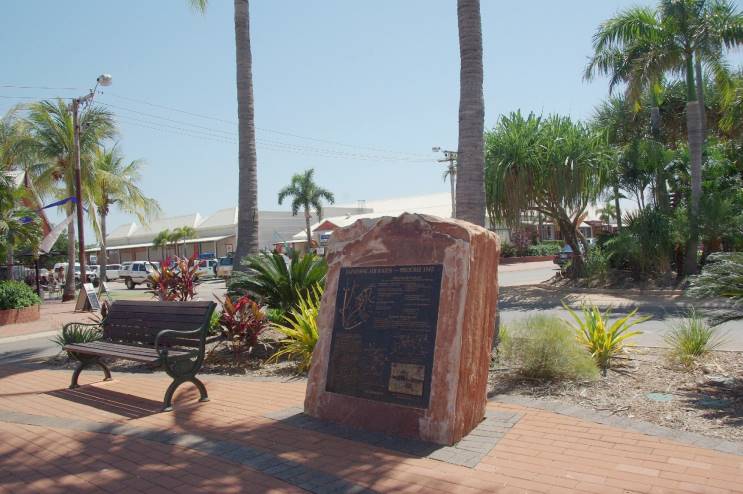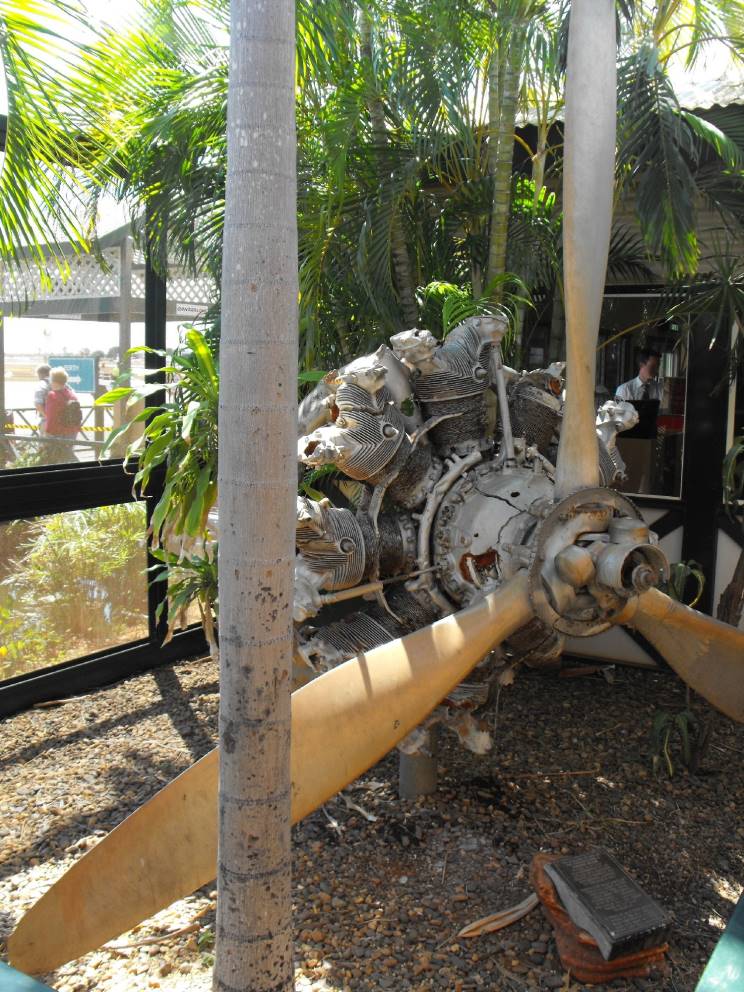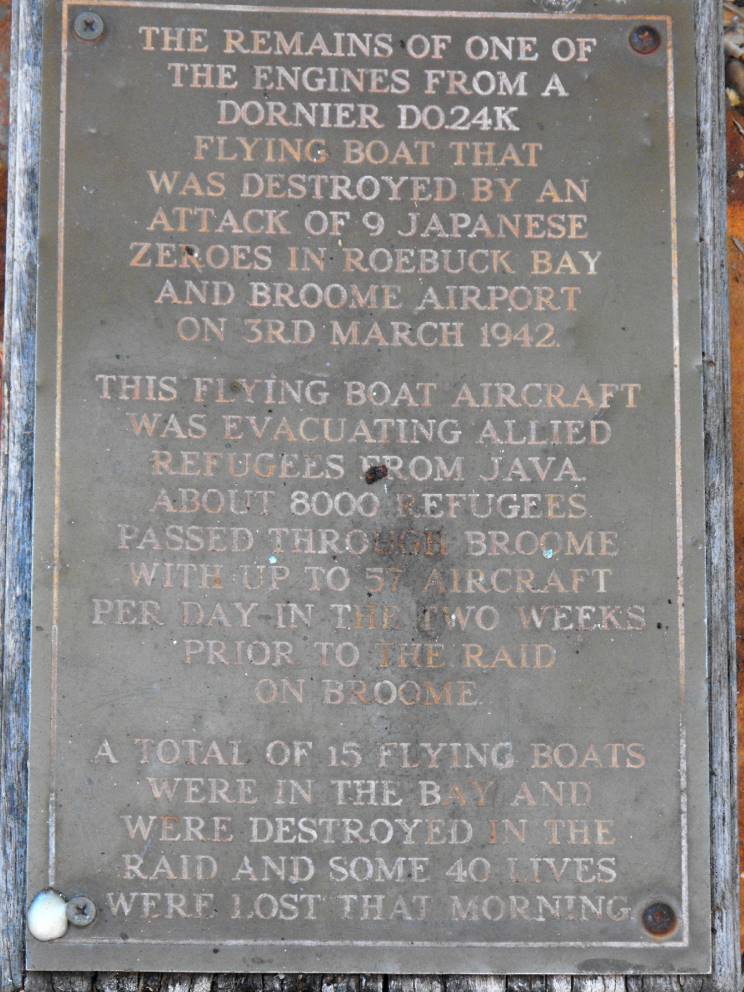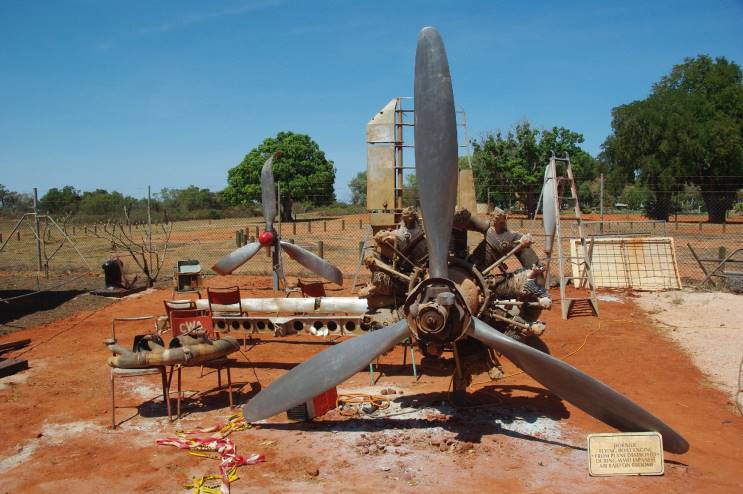Broome Air Raid Memorials |
|
Broome, Western Australia, Australia |
 |
Memorials commemorating Japanese Air Raid on Broome 03 March 1942 |
Situated on the northern coast of Western Australia the town of Broome was in 1942 a small settlement seemingly far away from the rest of Australia and indeed the world. Not too much has changed to this day in this quite little town where pearling and tourism are the main activities. But events taking shape around the globe at that time would soon see Broome briefly face its own Day of Infamy. Europe was plunged into conflict when the Nazi blitzkrieg invaded Poland on 01 September 1939. Then, in May and June 1940 when they struck westward, the Nazis quickly overran the Low Countries and routed the French and British Expeditionary Force, leading to evacuation of the beleaguered BEF and French armies from Dunkirk between May 26 and June 4. Capitulation of France followed on 22 June. In just 10 months German forces were in control of Western Europe and Britain stood alone. With the cream of the Australian armed forces already serving in North Africa and the Mediterranean between 1939 and 1941, the Australian mainland had been left poorly defended, ill equipped and largely unprepared. As early as 1937 the Japanese Imperial Forces were a well trained, well equipped and battle hardened force involved in full-scale conflict, having annexed Manchuria in 1932 and conquering Korea and much of eastern China by 1940. In need of further conquests to ensure the supply of raw materials, the Japanese struck southwards into SE Asia to secure the oil, rubber and other resources they so desired. On the morning of 07 December 1941 the Japanese forces launched near simultaneous attacks against the American Pacific Fleet at Pearl Harbour, the British colony at Hong Kong, the Philippines and an invasion fleet landed on the north east coast of Thailand and Malaysia, swiftly moving southward along the Malayan Peninsula culminating in the surrender of Singapore just 9 weeks later on 14 February 1942. Throughout January 1942 the seemingly unstoppable Japanese forces swept into the Dutch East Indies, Burma, New Britain, New Guinea, islands of the south west Pacific and onto the Solomon Islands. On 19 February 1942 the unprepared city of Darwin in northern Australia was attacked by two waves of Japanese aircraft - the carrier based force that had attacked Pearl Harbour just 9 weeks earlier followed by land based high altitude bombers flying from Timor. By this stage Broome had become a staging point for civilians evacuating from the Dutch East Indies as the Japanese forces landed on Java. On 02 March a Japanese reconnaissance aircraft flew unimpeded over Broome observing 8 large aircraft at Broome aerodrome and, fearing Allied counter attacks, the Japanese commanders decided to remove what they saw as a possible threat. However, the almost totally unprepared state of Australian defences at that time meant there was no effective fighter defence available across the entire northern part of Australia. The handful of USAAF Curtiss P40E Kittyhawk fighters available for the defence of northern Australia had been destroyed during the raid on Darwin less than 2 weeks earlier. Unbeknown to the Japanese, during 02 March and in the early morning hours of 03 March a total of 15 seaplanes crammed full with civilian evacuees from Java, many Dutch women and children, had arrived at Broome. These were moored on Roebuck Bay while being refuelled as they awaited the incoming tide in preparation for taking off and heading further south. A flight of 9 Mitsubishi A6M2 "Zero" fighters plus 1 Mitsubishi C5M2 "Babs" recon/control aircraft arrived over Broome 0930 on 03 March 1942. 3 Zeros immediately attacked the seaplanes on Roebuck Bay with cannon and machine gun fire while those assigned to attack the airport initially pursued a U.S. B24-A Liberator transport, downing it for loss of one their own before returning to the aerodrome. The third trio remained as top cover to deal with expected - but nonexistent - fighter defence. They too soon joined the fray also strafing with cannon and machine gun fire. No bombs were dropped on Broome during this raid but the Zeros jettisoned their long-range fuel tanks prior to the attack. This has sometimes been mistaken for bombing. Departing northward about one hour after their initial attack began, the Japanese left behind the burning wrecks of 8 land based bombers and transports plus 15 seaplanes ablaze and sunk on Roebuck Bay. The total number of casualties is still unclear due to the panic associated with the escape from Java and therefore no definitive record of the actual number of Dutch civilians on board the seaplanes. It is believed no fewer than 84 service personnel and civilians lost their lives during the attack but the actual number is likely to be somewhat higher. There were no organised anti-aircraft defences in Broome. Return machine gun fire against the attackers came only from several of the aircraft before their destruction and from the Dutch pilot Lt. Gus Winckel who had removed the gun from his Lockheed Lodestar just prior to the raid. Members of the local Volunteer Defence Corps and RAAF guards used their pistols and .030 rifles. Despite this somewhat inadequate defence, it appears that six of the seven Zeros that returned to Timor had been holed by ground fire. Japanese losses were 1 Zero shot down by defensive fire from the US Army Air Corps B-24 and a second ditched off Roti Island near Timor, due to damage and subsequent loss of fuel caused by ground fire. A third pilot was wounded by ground fire. Further raids on Broome during 1942 occurred on 20 March and 27 August and the final raid was on 16 August 1943 but none were as damaging as that on 3 March 1942. Four memorials within the township commemorate the WWII air raids on Broome. A memorial and plaque, Japanese Air Raids - Broome 1942 (Shown above), located close to the town centre gives the story and circumstances of the 03 March raid and lists the aircraft involved and those lost during the action. The Allied War Memorial Wall (shown below) that is located within the Bedford Memorial Park, overlooking Roebuck Bay. This lists those known to have lost their lived and also recognises the unknown number of missing and unidentified U.S. servicemen and Dutch civilians. |
|
At Town Beach overlooking Roebuck Bay is a plaque commemorating the 50th anniversary of the air raids on which is mentioned the "bombing" of Broome. Also at Town Beach is a plaque commemorating 76 of the Dutch civilians who were lost during the raid and who were initially buried there. Wreckage from the seaplanes destroyed on Roebuck Bay can still be seen as extreme low tides expose the mud flats of the bay. Engines recovered from Dornier Do24K seaplanes (shown below) of the Royal Netherlands Air Force are on display at the Broome Historical Society museum and near the departure gate of Broome Airport. |
 |
 |
 |
(All photos and text courtesy of Peter F. Williams) © 2011 Peter F. Williams all rights reserved |
Page published Nov. 19, 2013 |